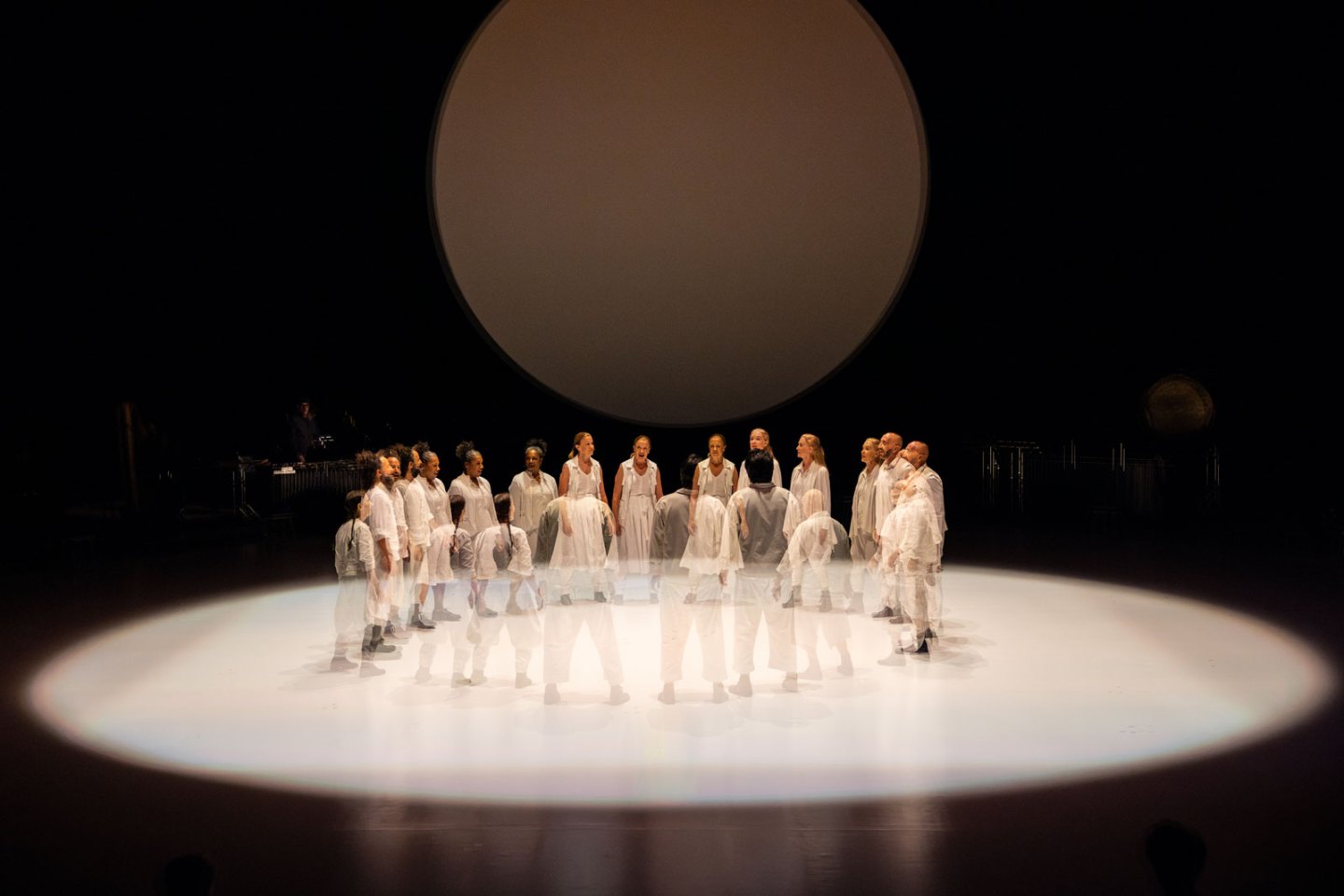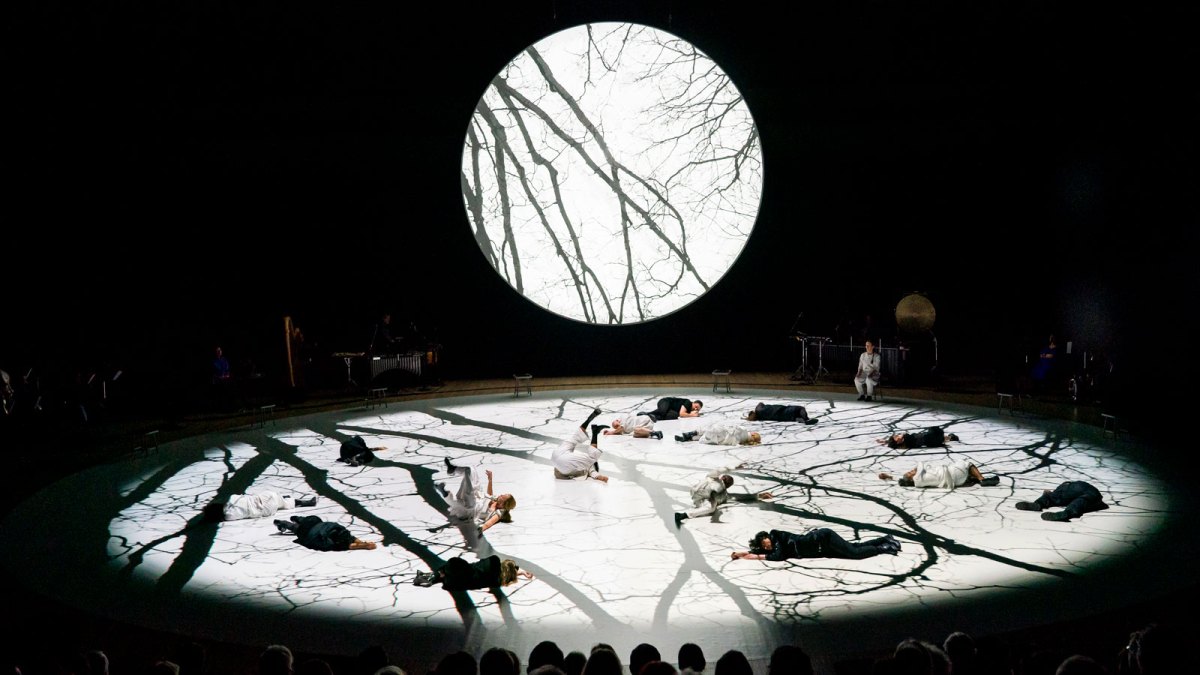Inspired by the ancient legend of Indra’s net, which depicts the Buddhist concept of interpenetration, Meredith Monk’s latest work metaphorizes the interdependency of humans with the natural world. “Indra’s Net” meditates on the earth’s vulnerability through a multimodal interplay of sound, silence, gesture, space, and time. Throughout the performance, Monk, her cohort of seven other vocalists, and a team of instrumentalists sonified the planet’s precarity, while a giant orb towered behind them in the background. At times the orb glittered with an assortment of minimalist, mostly black-and-white video projections; during the final vignette, the tops of the performers’ heads were scattered like jewels across the orb as it played host to an aerial view of the stage. In fact, the legend’s titular net is studded with jewels signifying everything we ever do, everything done to us, and how the effects of our actions inescapably alter the entire balance of the net: “At every node in this net there is a precious jewel, and whatever affects one jewel affects all of them.”
Monk is spry for her age—she has the exact same birthday as Joe Biden—and effuses an almost childlike enthusiasm in the act of performing. Monk’s face radiates joy between her two long thin braids; despite decades of performance, she clearly still derives genuine glee from weaving a patchwork of musical, choreographic, vocal, visual, spatial, and philosophical strands. Although not quite as deftly agile as her co-performers, Monk leapt and strolled around the space as fluidly as the vowels she volleyed across it. Her presence suffused the 55,000 square feet of the Park Avenue Armory’s Wade Thompson Drill Hall, which Monk described as “the ideal venue” for this work, here presented in its North American premiere.
The Park Avenue Armory run of “Indra’s Net,” which was first performed in 2023 at the Holland Festival, marks Monk’s 60th season of performing. “Indra’s Net” also completes Monk’s trilogy of music-theater works, spanning nearly a decade, that musicalize her cosmology of “performance as a life science.” The first two installments of the trilogy, “On Behalf of Nature” (2013) and “Cellular Songs” (2018), also explore the interconnectedness of human life and the human body with that of our natural world, which our actions have engulfed with climate disaster, destruction, genocide, and a sweeping, resigned hopelessness. While similar in many ways to “Cellular Songs” (and indeed, to Monk’s general corpus), “Indra’s Net” illuminates the intersections and interstices of the eponymous net that signifies, as Monk puts it, “the principle of interdependence among all living things.”
The latest from VAN, delivered straight to your inbox
One of the most striking aspects of Monk’s latest composition is a multimedia element that does not feel contrived or distracting, but rather extends outward from the musical performance. (Monk describes film as “music for the eyes.”) Two installation shrines, titled “Anthem” and “Rotation,” act as hymnlike “connective tissue” embodying the piece’s message of boundary dissolution between humans and the natural world; the installations themselves blur boundaries, not only of space and time, but between fixed artistic object and live performance. For me, liveness has always been a central component of Monk’s performance practice, since her work emphasizes the dynamics of vocal gesture, physical gesture, and spatial acoustics. But rehearsals for “Indra’s Net” began in March of 2020, right as the world descended into a seemingly unending lockdown. Given these limitations, Monk crafted audio-video installations through which, during a live performance, audience-goers become gently immersed in the realm of the performance, but in its initial context could act as “meditations for people to listen to and watch at home.”

Monk excels in the realm of contextualization, while staying firmly rooted in the aesthetic she has honed over the past 60 years. “Indra’s Net” seems to seamlessly grow out of “Cellular Songs,” the second piece in the trilogy, which I experienced at the Brooklyn Academy of Music a few years ago. As then, the concern lies with the interconnectedness of humans and nature: the performers bob around the space clad in white jumpsuits; the filmic elements evoke fragile ecologies and relationships. In “Indra’s Net,” as in “Cellular Songs,” Yoshio Yabara contributed scenography and costumes, and Joe Levasseur contributed the stunning lighting design. The shrines, both of which were conceived and directed by Monk, provided yet another dimension to the composition; they were neither extraneous, as if communicating something entirely unrelated, nor redundant, as if merely using a different medium to communicate the same thing the music was.
Despite these similarities, “Indra’s Net” can stand on its own; in fact, I would recommend the experience to a Monk novice, as it functions as a solid introduction to her style of extended vocal technique, as well as to the sense of asynchronous spirituality that imbues her oeuvre. Most striking to me were the vocal harmonies and dissonances and clucks and clicks. As usual, I was enchanted by Monk’s capacity for narrative without words, as the human voice itself becomes a vehicle for story, character, metaphor, synecdoche. Her sounds exist at the border between speech and textless musical vocalization; Monk explains in conversation with Bonnie Marranca that “even if the singing is abstract, sometimes it has a conversational quality.” Monk’s comrades, including longtime collaborators Allison Sniffin and Theo Bleckmann, layered their voices, physical movements and facial expressions into a mélange of curiosity, humor, fear, frustration, and anticipation. The group, totaling eight vocalists, were joined by a team of instrumentalists who matched the singers in enthusiasm and (to my perhaps unwarranted surprise) subtle adeptness. One highlight was an extended percussion duo (duel?); another was the finale, mentioned above.
Throughout the 90-minute performance, I felt at times as if I had gotten punched in the heart because the experience was so unconventionally gorgeous. At others I simply wanted to pick up Meredith Monk and twirl her around! She and her comrades were having such fun, and their exuberance was infectious. Despite the grave significance of Monk’s message, it was transmitted with an unabashed earnestness that felt both uncommon and welcome. And although at times silly on its surface, Monk’s art exudes symmetry, spirituality, consistency, and geometric precision. In “Indra’s Net” she strikes a delicate balance between whimsy and solemnity, teetering on the brink of lamentation while ultimately conveying a wordless message of rare hope. ¶
Subscribers keep VAN running!
VAN is proud to be an independent classical music magazine thanks to our subscribers. For just over 10 cents a day, you can enjoy unlimited access to over 875 articles in our archives—and get new ones delivered straight to your inbox each week.
Not ready to commit to a full year?
You can test-drive VAN for one month for the price of a coffee.


